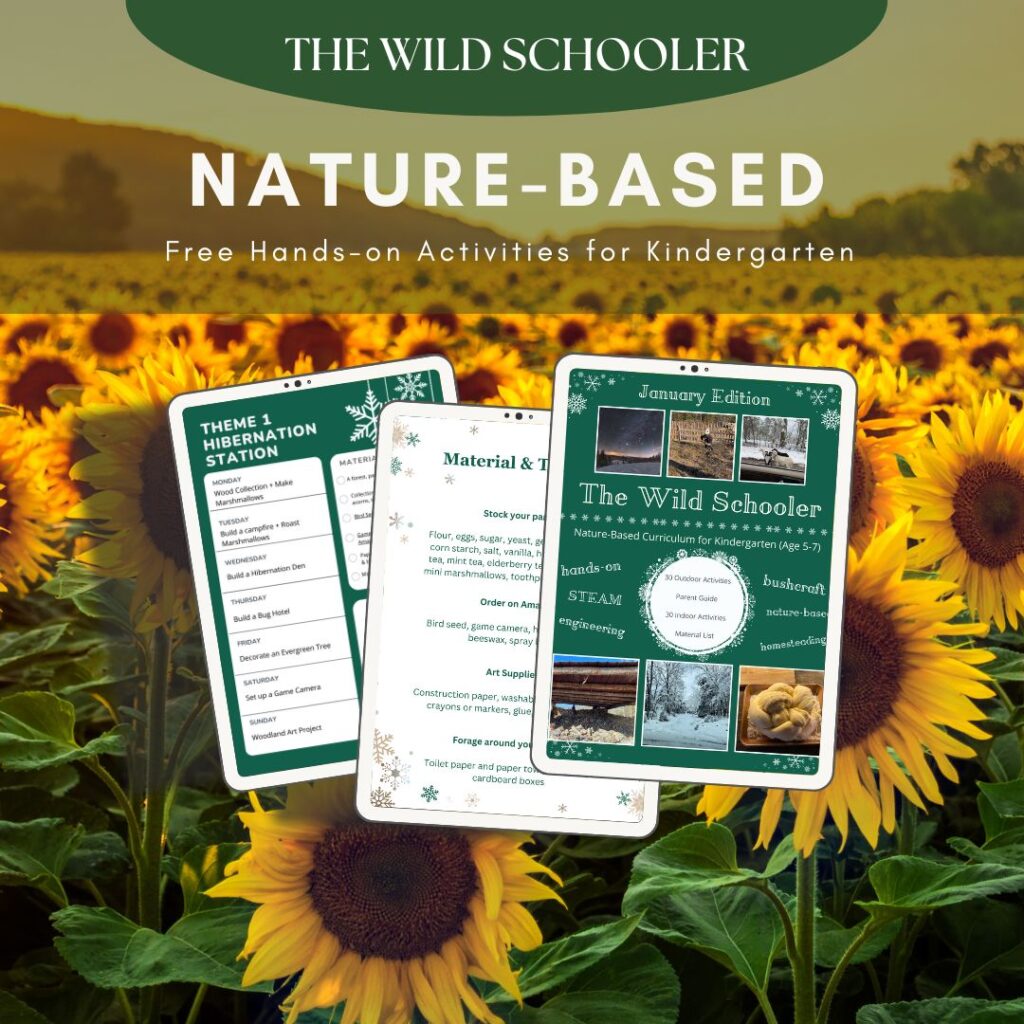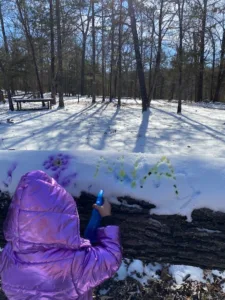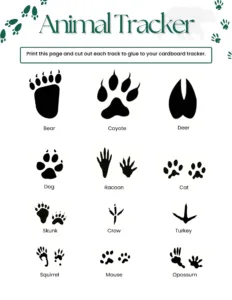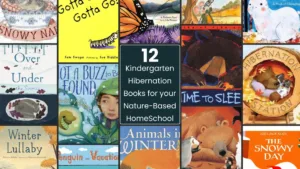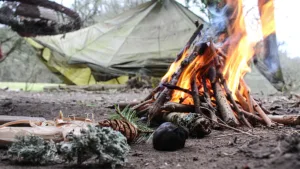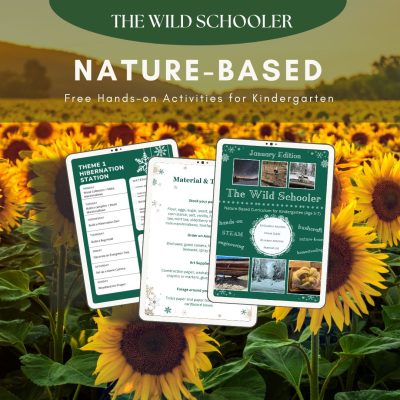Wild schooling is a transformative approach to homeschooling where children get to explore the wonders of education in the great outdoors. At its core, wild schooling is more than a method; it’s a philosophy that embraces nature as the ultimate classroom, fostering a profound connection between learning and the natural world. In this blog post, we’ll examine the essence of wild schooling, exploring its benefits, practical applications and ideas for nature-based curriculum that you can use to create your own wild school at home.
Whether you’re a seasoned homeschooler seeking to add nature-based elements to your homeschool curriculum or a parent that’s just curious about other education methods, you’re in the right place! We will unravel the concept of wild schooling and discover how it can improve the educational experience for homeschooling families with an interest in nature-based education.
Origins and Philosophy of Wildschooling
Wildschooling is more than an educational approach; it’s a philosophy that champions the idea of using the natural world as a dynamic and immersive learning environment. Rooted in the belief that nature itself is the best teacher, Wildschooling draws inspiration from various educational philosophies, including forest schools and nature-based learning movements. The approach encourages a holistic understanding of education, emphasizing not only academic knowledge but also the development of a deep, personal connection to the environment.
How is Wildschooling Different From Traditional Homeschooling and Unschooling:
Unlike traditional homeschooling, where learning often takes place within the confines of a home or designated study space, Wildschooling breaks down these barriers by extending the classroom to the outdoors. While both approaches share the fundamental goal of personalized education, Wildschooling uniquely integrates the natural world into every aspect of the learning journey.
In comparison to the philosophy of unschooling, which emphasizes child-led learning without a predetermined curriculum, Wildschooling introduces a structured yet flexible framework that combines a nature-based curriculum with the spontaneity of exploration.
@thewildschooler What if we reimagined school? What if our classrooms became gardens, mud kitchens, tree houses ans libraries? Children cannot bounce off the walls if you take the walls away. #wildschooling #wildschool #forestchild #forestchildren #forestschool #cottagecore #homeschool #homeschooling #homeschoolmom #homeschooled #ozarks #homestead #homesteading #freeschooling #unschooling #unschoolinglife #unschoolingmom #childledlearning #childledlearningthroughplay #wildchild #wildchildrenatplay
♬ original sound – United by healing
The Wild Schooler currently offers a free nature-based curriculum for kindergarten that you can download here.
Benefits of Wildschooling
Positive Impacts on Child Development
Wildschooling unfolds a myriad of benefits that positively influence a child’s overall development. By immersing children in the natural world, they not only acquire academic knowledge but also cultivate essential life skills. Outdoor exploration enhances physical health, fostering robust motor skills and a genuine appreciation for an active lifestyle. Moreover, exposure to nature stimulates creativity, critical thinking, and problem-solving abilities. As children navigate the unpredictability of their earth school, they develop resilience, adaptability, and a profound sense of self-confidence.
Emphasis on Holistic Learning
The heart of Wildschooling lies in the recognition that true education extends beyond textbooks. Nature becomes a rich tapestry for holistic learning, where subjects seamlessly blend, and real-world experiences shape understanding. The interconnectedness of flora, fauna, and ecological systems serves as a living textbook, offering lessons in biology, ecology, and environmental science. Beyond academics, the outdoor setting facilitates social and emotional growth, fostering empathy, cooperation, and a deep sense of environmental responsibility. In this section, we’ll explore these benefits in depth, unveiling the transformative impact Wildschooling can have on a child’s holistic development.
The transformative impact of Wildschooling lies in its ability to engage all facets of a child’s being—cognitive, emotional, social, and physical—within the rich tapestry of the natural environment.
1. Cognitive Development:
Wildschooling, with its emphasis on unstructured play and exploration, becomes a dynamic laboratory for cognitive development. In the vast expanse of nature, children encounter an ever-changing landscape that sparks curiosity, problem-solving, and critical thinking. Observing the intricacies of the natural world, from the patterns of leaves to the behaviors of wildlife, instills a love for inquiry and a deep understanding of scientific concepts.
2. Emotional Resilience:
The emotional well-being of a child flourishes in the open spaces and serene settings that Wildschooling provides. Unrestricted by the confines of a traditional classroom, children have the freedom to explore and express themselves authentically. This autonomy fosters emotional resilience, confidence, and a profound sense of self. Nature, with its calming influence, becomes a natural sanctuary for emotional growth and self-discovery.
3. Social Connection:
Contrary to concerns about socialization, Wildschooling cultivates meaningful social connections. Through group activities, nature excursions, and community engagement, children develop crucial social skills in an organic and unforced manner. The shared experiences of outdoor adventures forge bonds, teaching cooperation, empathy, and effective communication.
4. Physical Well-Being:
In the vast playground of nature, physical well-being takes center stage. Wildschooling promotes active lifestyles, with children engaging in activities that enhance both gross and fine motor skills. Climbing, running, and exploring the natural terrain contribute to physical fitness, instilling a love for movement and an appreciation for a healthy, active lifestyle.
Transform Your Homeschool Into a Wildschool
How to Design an Outdoor Learning Space
One of the foundational aspects of Wildschooling is the creation of a nature-friendly learning environment. Transforming your outdoor space into an inviting and educational haven involves thoughtful planning. Consider the layout, ensuring it encourages exploration and discovery. Integrate comfortable seating areas for lessons, nature-inspired play zones, and perhaps even a designated area for hands-on projects. Embracing the concept of an outdoor classroom fosters a seamless transition between indoor and outdoor learning, allowing children to absorb knowledge in a dynamic and natural setting.
How to Incorporate Nature into the Home Environment
While outdoor spaces are central to Wildschooling, the principles of nature-based learning can also be infused indoors. Bring the outside in by incorporating natural elements throughout your home. Consider using natural materials for furniture, such as wooden tables and chairs, to create a warm and earthy atmosphere. Decorate with plants, rocks, and shells to provide a connection to the outdoors even when inside. You could add a fish tank, or a terrarium with lizards, frogs, snakes, etc. This section will provide practical tips on how to seamlessly blend the indoor and outdoor learning environments, ensuring that the benefits of Wildschooling are not confined to a specific space but become an integral part of your homeschooling journey.
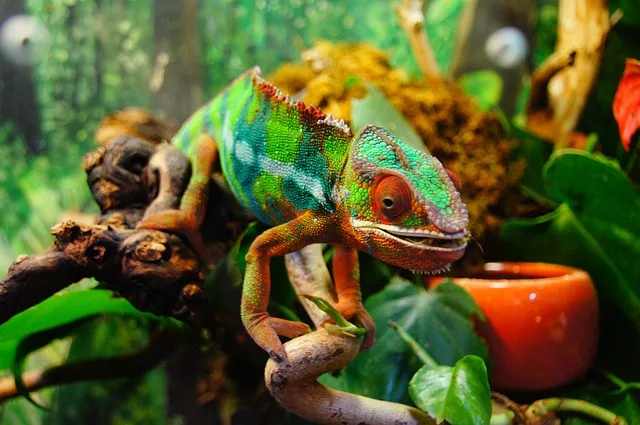
Practical Tips for Blending Indoor and Outdoor Learning Environments in Wildschooling:
Create a Nature-Inspired Learning Corner:
- Dedicate a corner of your indoor space to showcase nature-inspired elements. Include potted plants, nature-themed artwork, and a small shelf for field guides and natural artifacts. This designated area serves as a reminder of the outdoor world and a cozy space for focused learning.
Flexible Indoor-Outdoor Transitions:
- Design your indoor learning space with easy access to the outdoors. Consider having a sliding door or large windows that open to a garden or patio. This seamless transition allows for spontaneous outdoor exploration, making learning a continuous and flexible experience.
Use Natural Materials in Learning Resources:
- Infuse your learning materials with natural elements. Choose wooden desks, chairs, and shelves. Incorporate natural fabrics, like wool or cotton, in rugs and cushions. This tactile experience brings the essence of nature indoors, fostering a harmonious blend between the two environments.
Take Lessons Outdoors:
- Move traditional lessons outdoors when weather permits. Whether it’s reading, math exercises, or science experiments, the outdoor setting provides a dynamic backdrop that enhances engagement and creativity. Bring learning materials outside and let nature be the classroom.
Gardening as an Educational Tool:
- Integrate gardening into your curriculum. Create a small garden space where children can plant and nurture seeds, observe plant growth, and learn about the lifecycle of plants. This hands-on experience bridges the gap between indoor and outdoor learning, connecting academic concepts with real-world applications.
Outdoor Observation Journals:
- Provide each child with an outdoor observation journal. Encourage them to document their observations, sketches, and thoughts during outdoor exploration. This portable journal becomes a bridge between indoor reflection and outdoor discovery, creating a seamless connection between the two environments.
Nature-Based Learning Resources:
- Curate a collection of nature-based learning resources. Choose books, documentaries, and educational materials that focus on the natural world. Create a cozy reading nook indoors with a view of the outdoors, allowing children to immerse themselves in nature-themed learning.
Weather Stations and Nature Displays:
- Set up a weather station indoors, featuring a thermometer, barometer, and other weather instruments. This indoor display connects children to the outdoor environment, fostering an understanding of weather patterns and seasonal changes.
Bring Indoor Hobbies Outdoors:
- Encourage indoor hobbies, such as drawing, writing, or crafting, to take place outdoors. Provide portable art supplies, journals, or sketchbooks. This allows children to express themselves creatively while surrounded by the inspiration of nature.
Utilize Technology for Nature Exploration:
- Integrate technology to enhance outdoor learning. Use tablets or smartphones for nature identification apps, virtual plant dissections, or to capture photos for digital nature journals. This tech-savvy approach blends modern tools with the wonders of the natural world.
By implementing these practical tips, you can seamlessly blend indoor and outdoor learning environments, ensuring that the benefits of Wildschooling become an integral and harmonious part of your homeschooling journey. The goal is to create a fluid and dynamic educational experience where the boundaries between indoor and outdoor learning blur, allowing children to engage with the world around them in a holistic and immersive way.
Integrate Nature Into Lesson Plans
Nature-Based Curriculum and Resources
One of the distinguishing features of Wildschooling is the intentional integration of nature into lesson plans. This section will explore a variety of nature-based curriculum options and resources that align with the principles of Wildschooling. From science programs that utilize outdoor exploration to literature studies that focus on nature-themed books, there are abundant resources available to tailor your curriculum to the wonders of the natural world. We’ll delve into specific examples, providing insights into how these resources can enrich your child’s learning experience and deepen their connection to nature.
The Wild Schooler
This nature-based Kindergarten activity guide will help your child build skills in bushcraft, regenerative agriculture, homesteading, engineering, science, art and technology through highly engaging real-life experiences in nature.
Example Activity: Ice Suncatchers
- Start by discussing the magical transformation of water into ice and its unique qualities. Provide various containers, natural materials like leaves and small twigs, and colorful items like berries or buttons. Guide the children as they arrange these treasures in containers, fill them with water, and let them freeze overnight. The next day, marvel at the beautiful frozen creations and hang them in the sunlight, turning the ordinary into a dazzling display of nature’s art. This hands-on activity not only explores science concepts but also fosters creativity and appreciation for the wonders of winter.
Blossom and Root:
Known for its holistic approach to education, Blossom and Root offers curriculum options that seamlessly integrate nature into various subjects. From nature studies to hands-on science projects, their resources encourage outdoor exploration and experiential learning.
Example Activity: Nature Journaling
- Begin your day with a nature walk and encourage your child to observe and document their findings in a nature journal. This not only enhances observational skills but also serves as a creative outlet for self-expression.
Wild Math:
Wild Math provides a unique curriculum that transforms outdoor spaces into math learning environments. Through nature-inspired activities, games, and challenges, children develop mathematical skills while exploring the natural world.
Example Activity: Outdoor Math Scavenger Hunt
- Transform math lessons into an interactive scavenger hunt. Assign numerical values to natural items like leaves, rocks, or flowers, and have your child hunt for and organize them based on mathematical principles.
Nature Explorer Series by Raising Little Shoots:
This series is designed for parents who want to cultivate a love for nature through literature-based nature studies. With themed guides covering various aspects of the natural world, it provides a rich foundation for homeschooling families.
Example Activity: Botanical Art Exploration
- Combine art and science by exploring botanical art. Pick a plant, observe its features, and create detailed botanical illustrations. This activity enhances artistic skills while deepening knowledge of plant anatomy.
Exploring Nature with Children:
A year-long curriculum designed to guide families through weekly nature studies, “Exploring Nature with Children” covers a wide range of topics from seasons and weather to plants and animals. It includes literature suggestions, hands-on activities, and journaling prompts.
Example Activity: Seasonal Phenology Study
- Engage in a long-term study of seasonal changes. Record observations of plants, animals, and weather throughout the year. This ongoing project teaches scientific observation and data collection.
NatureGlo’s eScience:
NatureGlo’s eScience offers online courses that combine math and science with a focus on the natural world. Courses like “MathArt: Patterns in Nature” and “Exploring the Secret Life of Trees” bring math and science concepts to life through engaging outdoor exploration.
Example Activity: Fibonacci in Nature
- Explore the Fibonacci sequence in nature by examining pinecones, sunflowers, or seashells. This activity connects math to the natural world, fostering an understanding of mathematical patterns in living organisms.
Outdoor Hour Challenges by Handbook of Nature Study:
This resource provides a series of challenges that encourage families to observe and study nature throughout the seasons. It includes guided nature walks, journaling prompts, and hands-on activities suitable for various age groups.
Example Activity: Bird Watching and Identification
- Dedicate a lesson to bird watching. Use a field guide to identify local birds, and introduce concepts of biodiversity and ecological relationships. This hands-on experience enhances both science and observational skills.
Forest School Adventure: Outdoor Skills and Play for Children by Naomi Walmsley:
While not a curriculum per se, this book provides a wealth of ideas and activities for outdoor learning. It covers a range of skills, from building shelters to identifying plants, making it a valuable resource for Wildschooling parents.
Example Activity: Shelter Building and Outdoor Survival Skills
- Integrate practical outdoor skills by learning to build a shelter. This activity teaches survival skills, teamwork, and problem-solving, all while immersing your child in the natural environment.
The Nature Connection: An Outdoor Workbook for Kids, Families, and Classrooms by Clare Walker Leslie:
This workbook is a fantastic resource for incorporating nature into your homeschooling routine. It includes seasonal activities, nature journaling prompts, and observational exercises suitable for various ages.
Example Activity: Seasonal Phenomena Observations
- Use the workbook’s prompts to guide observations of seasonal phenomena such as changing leaf colors, migrating birds, or blooming flowers. This encourages regular nature observations, creating a sense of connection to the changing environment.
Exploring these nature-based curriculum options can add depth and richness to your Wildschooling journey, providing diverse ways to connect your child with the wonders of the natural world.
Ideas for Incorporating Outdoor Activities into Subjects
Whether it’s math, science, language arts, or history, Wildschooling offers a flexible framework to infuse nature into every aspect of learning. Engage in botanical math exercises, where counting and sorting take place with natural elements. Explore scientific principles through hands-on experiments in the garden, and let literature come to life with outdoor storytelling sessions. This section will provide practical ideas and examples for incorporating the beauty of nature into your daily lesson plans, fostering a holistic and immersive educational experience for your homeschooling adventure.
Practical Ideas for Daily Lesson Plans:
Math in Nature:
Example Activity: Counting and Sorting Natural Objects
- Collect leaves, rocks, or pinecones during a nature walk. Practice counting and sorting, introducing mathematical concepts in a hands-on and engaging way.
Literature and Nature:
Example Activity: Outdoor Storytime
- Choose nature-themed books and read them outdoors. Encourage discussions about the stories and relate them to the natural surroundings for a literature lesson immersed in nature.
Science Exploration:
Example Activity: Pond Study
- Explore a local pond or water source. Observe aquatic life, study water ecosystems, and conduct simple water quality tests. This hands-on approach transforms a science lesson into an outdoor adventure.
Art and Nature:
Example Activity: Land Art Creations
- Use natural materials like leaves, sticks, and flowers to create land art. This activity fosters creativity and artistic expression while connecting art to the natural environment.
History in Nature:
Example Activity: Historical Nature Walk
- Research the history of your local area and embark on a nature walk to explore sites with historical significance. Connect the past to the present by discovering how nature has played a role in your community’s history.
By infusing your daily lesson plans with these practical ideas and examples, you’ll not only cover academic subjects but also create a truly immersive and holistic learning experience that fosters a deep connection between your child and the natural world.
Seasonal and Nature-Based Learning
Aligning Lessons with the Seasons
One of the unique strengths of Wildschooling lies in its ability to embrace and synchronize with the changing seasons. Aligning lessons with the seasons not only enriches the learning experience but also deepens the connection between your child and the natural world. This section explores the importance of seasonal and nature-based learning, emphasizing the benefits of adapting your homeschooling approach to the ever-changing tapestry of the outdoors.
Importance of Seasonal Alignment
Understanding the rhythms of nature and its seasonal cycles offers a dynamic framework for learning. Seasons provide a natural structure for thematic studies, allowing children to witness the life cycles of plants, observe animal behaviors, and experience the nuances of weather patterns. By aligning lessons with the seasons, Wildschooling fosters a sense of curiosity and awareness, encouraging children to connect with the environment on a profound level.
Curriculum Adjustments for Different Times of the Year
Tailoring your curriculum to the seasons involves more than just changing the subject matter; it’s about embracing the unique opportunities each season presents. Here are examples of curriculum adjustments for different times of the year:
Fall – Harvest and Transformation:
Example Curriculum Adjustment: Fall Harvest Study
- Explore the concept of harvest by studying seasonal fruits and vegetables. Incorporate activities like apple picking, observing changing foliage, and learning about migration patterns of birds.
Winter – Dormancy and Adaptation:
Example Curriculum Adjustment: Winter Animal Adaptations
- Focus on how animals adapt to winter conditions. Study hibernation, migration, and winter survival strategies. Engage in bird watching and create a winter wildlife journal.
Spring – Renewal and Growth:
Example Curriculum Adjustment: Springtime Botany
- Dive into the study of plants during spring. Explore the life cycle of flowers, identify local plant species, and engage in gardening activities. Observe the emergence of new life in the natural world.
Summer – Exploration and Outdoor Adventures:
Example Curriculum Adjustment: Summer Nature Explorations
- Capitalize on the longer days by organizing outdoor adventures. From camping and nature hikes to stargazing, let summer be a time for hands-on exploration and appreciation of the natural world.
By adjusting your curriculum to align with the seasons, you not only cater to the inherent curiosity of your child but also provide a diverse and ever-changing learning landscape. This section aims to inspire Wildschooling parents to embrace the cyclical nature of the environment, creating a curriculum that mirrors the dynamic beauty of the natural world throughout the year.
Practical Tips for Wildschooling Parents
Embracing Unstructured Outdoor Play
In the world of Wildschooling, unstructured outdoor play takes center stage as a cornerstone of a child’s development. Unrestricted by predetermined rules, unstructured play allows children to engage with nature on their terms, fostering creativity, imagination, and a genuine sense of wonder. We wrote about the vital role of unstructured play in the Wildschooling journey, highlighting its positive impacts on a child’s cognitive, emotional, and physical well-being in this post:
3 Benefits of Unstructured Play in Your Homeschool
Suggestions for Fostering Independent Exploration
Encouraging independent exploration is key to nurturing a child’s sense of autonomy and self-discovery. Provide a variety of nature-inspired tools and materials—such as magnifying glasses, binoculars, and simple field guides—to spark curiosity. Create designated exploration zones where children can freely investigate the natural world. Resist the urge to structure every moment, allowing them to navigate, observe, and experiment at their own pace.
Overcoming Challenges in Wildschooling
Anticipating Common Concerns About Wildschooling and Providing Responses
While the wild schooling journey is rewarding, it’s not without its share of criticisms. This section anticipates and addresses some common worries that parents might have when considering wild schooling for their children.
Lack of Structure
- Wildschooling doesn’t abandon structure but redefines it. Nature provides its own rhythm and order, offering a dynamic and ever-changing environment that becomes the classroom. The flexibility in learning allows children to follow their interests organically.
Academic Rigor
- Wildschooling can be academically rigorous through nature-based studies. From biology to mathematics, the outdoor environment becomes a living laboratory, fostering a deep understanding of concepts in a hands-on and engaging manner.
Socialization
- Contrary to misconceptions, Wildschooling provides ample opportunities for socialization. Joining nature groups and community activities ensures that children interact with peers, fostering social skills in a natural setting.
Adapting to Different Learning Styles in Your Wildschool
One of the strengths of Wildschooling lies in its ability to adapt to diverse learning styles. This section explores how the dynamic outdoor environment accommodates various learning preferences, catering to visual, auditory, kinesthetic, and other learning styles.
Visual Learners:
- Adaptation: Incorporate nature journals, visual guides, and observation-based activities. Visual learners thrive in the vibrant and visually stimulating outdoor setting.
Auditory Learners:
- Adaptation: Utilize outdoor spaces for storytelling, bird listening exercises, and engaging discussions. Nature provides a natural backdrop for auditory learners to absorb information.
Kinesthetic Learners:
- Adaptation: Integrate hands-on activities, exploration, and physical games. Wildschooling encourages movement and hands-on experiences, making it ideal for kinesthetic learners.
Tips for Adapting Outdoor Learning for Different Children
Understanding that every child is unique, this section offers practical tips for adapting outdoor learning experiences to cater to individual needs and preferences.
Tailoring Activities to Interests:
- Tip: Identify your child’s interests and incorporate nature-based activities related to those interests. Whether it’s wildlife, plants, or geology, aligning activities with their passions enhances engagement.
Flexibility in Learning Styles:
- Tip: Be open to experimenting with different learning styles. If a child responds better to experiential learning, focus on hands-on activities. Flexibility allows you to adapt your approach based on the child’s responses.
Collaborative Learning Opportunities:
- Tip: Foster collaborative learning by organizing group activities. Group exploration and projects provide opportunities for diverse learning styles to complement and support each other.
In navigating the diverse landscape of learning styles and overcoming challenges, Wildschooling emerges as a flexible and adaptive educational approach that celebrates the uniqueness of each child. This section aims to empower parents with the knowledge and tools needed to tailor their Wildschooling experience to suit the individual needs of their children.
We’ve explored the fundamental principles that make wildschooling a transformative journey for homeschooling families. From unstructured outdoor play to nature journaling and adapting to diverse learning styles, Wildschooling unfolds as an immersive and holistic educational adventure.
We’ve discovered the profound impact of unstructured play on cognitive, emotional, and physical well-being, as well as how Wildschooling accommodates diverse learning styles. The benefits are vast—cognitive development, emotional resilience, and an enduring connection to nature.
What is the Kindergarten Nature Study?
The Wild Schooler releases monthly nature-based curriculum that follows the seasons of the year and helps you to build a strong connection between your kindergartener and nature. We provide you with a parent guide of over 40+ indoor and outdoor engaging activities (complete with material lists) that help to build skills around STEAM, bushcraft, homesteading and homemaking, making it easy for you to wild school your homeschooler!
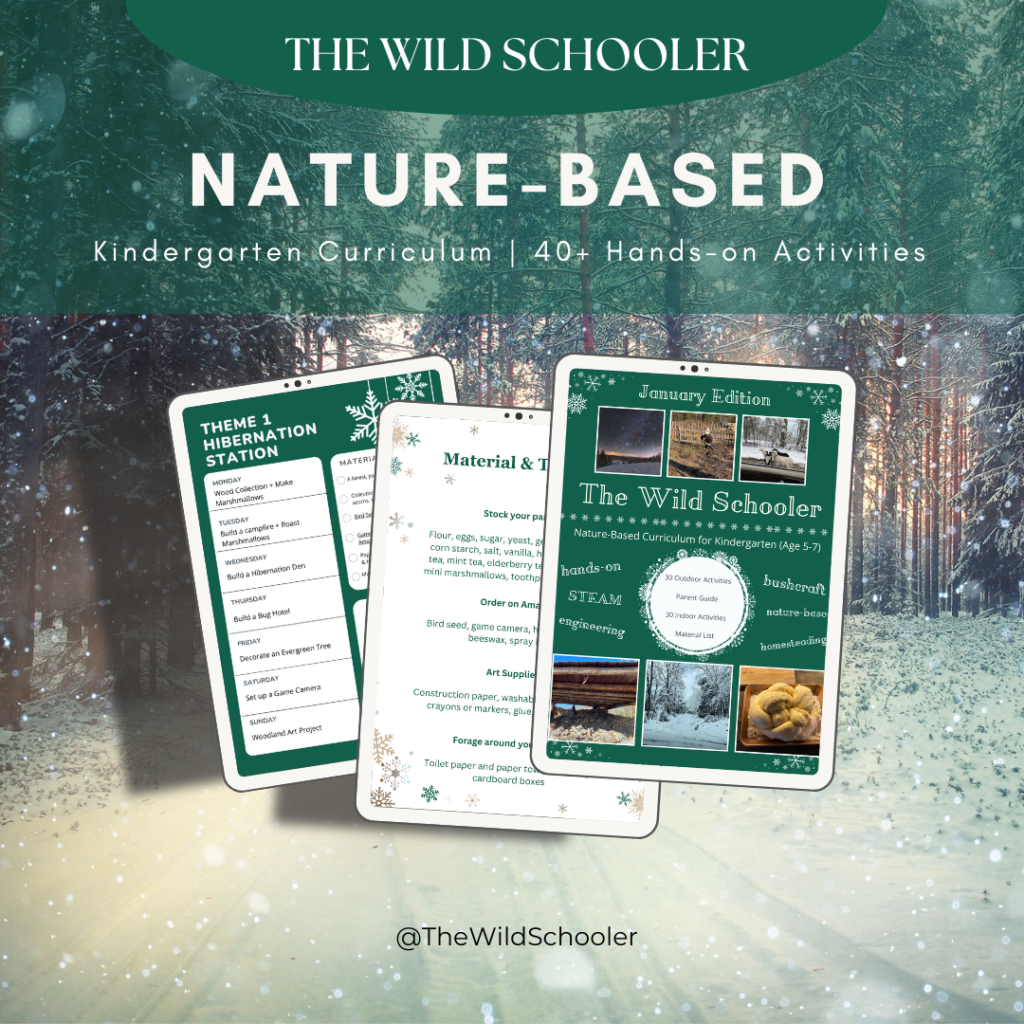
It’s free for the first month (then just $7) so download the parent guide of nature-based activities if you want to try it out.

